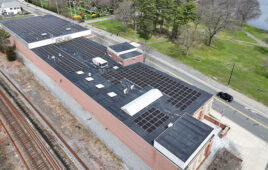Walmart today announced it is targeting zero emissions across the company’s global operations by 2040. Walmart and the Walmart Foundation are also committing to help protect, manage or restore at least 50 million acres of land and 1 million square miles of ocean by 2030 to help combat the cascading loss of nature threatening the planet.
“We want to play an important role in transforming the world’s supply chains to be regenerative. We face a growing crisis of climate change and nature loss and we all need to take action with urgency,” said Doug McMillon, president and chief executive officer, Walmart. “For 15 years, we have been partnering to do the work and continually raising our sustainability ambitions across climate action, nature, waste and people. The commitments we’re making today not only aim to decarbonize Walmart’s global operations, they also put us on the path to becoming a regenerative company – one that works to restore, renew and replenish in addition to preserving our planet, and encourages others to do the same.”
To avoid the worst effects of climate change, the world must take immediate action to drastically reduce and remove greenhouse gas emissions. That’s why Walmart is building on its long-standing commitment to climate action by raising its ambition to zero emissions by 2040, without the use of carbon offsets, across its global operations by:
- Harvesting enough wind, solar and other renewable energy sources to power its facilities with 100% renewable energy by 2035;
- Electrifying and zeroing out emissions from all of its vehicles, including long-haul trucks, by 2040; and
- Transitioning to low-impact refrigerants for cooling and electrified equipment for heating in its stores, clubs, and data and distribution centers by 2040.
The world has also pushed its natural resources to the point of crisis, resulting in the degradation and loss of critical landscapes and the eradication of many species of plants and animals. In fact, studies show animal populations have declined by over 60% in just over 40 years and one-fifth of the Amazon’s rainforest has disappeared in just 50 years. Not only can a regenerative approach to nature help reverse these negative impacts and sustain critical resources for the future, it can also provide around one-third of the solution to climate change.
“We must all take urgent, sustained action to reverse nature loss and emissions before we reach a tipping point from which we will not recover,” said Kathleen McLaughlin, executive vice president and chief sustainability officer for Walmart and president of the Walmart Foundation. “People have pushed past the earth’s natural limits. Healthy societies, resilient economies and thriving businesses rely on nature. Our vision at Walmart is to help transform food and product supply chains to be regenerative, working in harmony with nature – to protect, restore and sustainably use our natural resources.”
Recognizing the need to act now, along with the Walmart Foundation, Walmart aims to protect, manage or restore some of the world’s most critical landscapes by:
- Continuing to support efforts to preserve at least one acre of natural habitat for every acre of land developed by the company in the United States;
- Driving the adoption of regenerative agriculture practices, sustainable fisheries management and forest protection and restoration – including an expansion of Walmart’s forests policy; and
- Investing in and working with suppliers to source from placed-based efforts that help preserve natural ecosystems and improve livelihoods.
For more than 15 years, Walmart has been collaborating with others to drive positive change across global supply chains. The company’s sustainability efforts prioritize people and the planet by aiming to source responsibly, sell sustainable products, protect natural resources and reduce waste and emissions. To date, Walmart powers around 29% of its operations with renewable energy and diverts approximately 80% of its waste from landfills and incineration globally. Because most of the company’s environmental impact comes from its supply chain, Walmart is also working with suppliers through its Project Gigaton initiative to avoid a gigaton of greenhouse gas emissions by 2030. More than 2,300 suppliers have signed on, and since the effort launched in 2017, suppliers report a total of 230 million metric tons of avoided emissions.
News item from Walmart





“Harvesting enough wind, solar and other renewable energy sources to power its facilities with 100% renewable energy by 2035;
Electrifying and zeroing out emissions from all of its vehicles, including long-haul trucks, by 2040; and
Transitioning to low-impact refrigerants for cooling and electrified equipment for heating in its stores, clubs, and data and distribution centers by 2040.”
That is fairly aggressive. One must wonder, IF class 8 BEV rigs come to market sooner, will Walmart accelerate their uptake of BEV long haul fleets?
Transition to low-impact refrigerants ? Nitrogen? Oxygen? Some kind of non fluorocarbon refrigerant?
“To date, Walmart powers around 29% of its operations with renewable energy and diverts approximately 80% of its waste from landfills and incineration globally. Because most of the company’s environmental impact comes from its supply chain, Walmart is also working with suppliers through its Project Gigaton initiative to avoid a gigaton of greenhouse gas emissions by 2030. More than 2,300 suppliers have signed on, and since the effort launched in 2017, suppliers report a total of 230 million metric tons of avoided emissions.”
It looks to me like some of the cheap plastic stuff Walmart sells, (or doesn’t sell) ends up on the shelves of ‘Big Lots’. So, does Walmart subtract this from their waste stream if it’s sold in bulk to another dollar store entity?